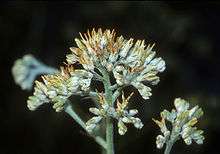Lachnanthes
Lachnanthes is a genus of monocotyledonous plants in the bloodwort family containing only one species, i.e., Lachnanthes caroliniana,[3] commonly known as Carolina redroot or bloodroot.[4] The plant is native to eastern North America, from southeastern Nova Scotia (especially the Molega Lake area)[5] and Massachusetts in the north, south to Florida and Cuba, and west along the Gulf of Mexico to Louisiana. It has also been reported from an island in the western Caribbean off the coast of Honduras.[6] It prefers wet, acidic, usually sandy soils, restricting it to various wetland habitats such as bogs, pinelands, hammocks and pocosins, among others.
| Lachnanthes | |
|---|---|
 | |
| Lachnanthes caroliniana | |
| Scientific classification | |
| Kingdom: | Plantae |
| Clade: | Tracheophytes |
| Clade: | Angiosperms |
| Clade: | Monocots |
| Clade: | Commelinids |
| Order: | Commelinales |
| Family: | Haemodoraceae |
| Subfamily: | Haemodoroideae |
| Genus: | Lachnanthes Ell. |
| Species: | L. caroliniana |
| Binomial name | |
| Lachnanthes caroliniana | |
| Synonyms[1][2] | |
| |
The plant's common name is based on its red roots and rhizomes. Its flowers, consisting of six pale yellow tepals, emerge from mid to late summer. The plant is sometimes a significant weed in commercial cranberry bogs.[7]
Taxonomy
The generic name "Lachnanthes" is a conserved name in botany. This means that the name has been granted a special exemption to the ordinary priority rules, allowing a newer name to be used instead of an older one. Three names are relevant here:[8]
Heritiera Aiton, Hortus Kewensis 3: 546. 1789.
Heritiera J.F. Gmelin, Systema Naturae, ed. 13 2: 113. 1791.
Lachnanthes S. Elliott, Sketch of the Botany of South-Carolina and Georgia 1: 47. 1816.
The first is a different plant, a tropical tree. This makes the second name an illegitimate homonym, unusable. The conservation decree allows the third name to be used in place of the second to refer to the plant now called Lachnanthes caroliniana.
References
- Tropicos
- The Plant List
- Dandy, James Edgar. Journal of Botany, British and Foreign 70: 329. 1932.
- "Encyclopedia of Life".
- Ware, Beverley (2007), "Knox on Wood" (PDF), The Novascotian, archived from the original (PDF) on 31 March 2012, retrieved 10 April 2011
- Kew World Checklist of Selected Plant Families
- Robertson, Kenneth R. (2003), "Lachnanthes caroliniana", in Flora of North America Editorial Committee, eds. 1993+ (ed.), Flora of North America online, 26, New York & Oxford: Oxford University Press, pp. 47–48, retrieved 2008-11-17
- Rare and Endangered Plant Seed Bank, Missouri Botanical Garden
External links

- Distribution Map in North America from Flora of North America
- Illustration from Flora of North America
- Video from University of Florida